It looks like you're using an Ad Blocker.
Please white-list or disable AboveTopSecret.com in your ad-blocking tool.
Thank you.
Some features of ATS will be disabled while you continue to use an ad-blocker.
share:
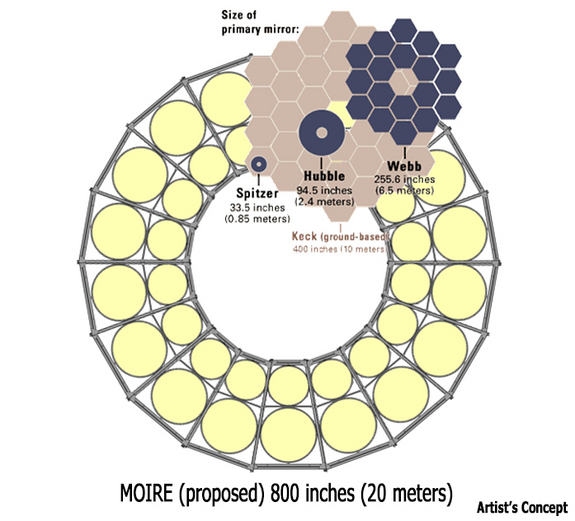
As you know, one thing which gets under my skin as a student of science is the money that gets wasted on duplicate research and instruments that science wants but the military locks up under the auspices of "National Security".
I've hinted at this in the past in an ATS post. SEE the video in this post: Why the Black Budget is Bad for Science....
Now here is another glaring example....
From Space.com:
US Military Developing Foldable Space Telescope (Video, Images)
The United States military's advanced research arm is working on a foldable space telescope that could image Earth in high resolution at a relatively low cost.
The Defense Advanced Research Projects Agency (DARPA) says the telescope design — known as the Membrane Optical Imager for Real-Time Exploitation, or MOIRE — would be of great use in geosynchronous Earth orbit, the spot 22,000 miles (35,000 kilometers) up where most telecommunications satellites reside.
"Membrane optics could enable us to fit much larger, higher-resolution telescopes in smaller and lighter packages," Lt. Col. Larry Gunn, MOIRE program manager, said in a statement.
If the design ever reaches orbit, DARPA envisions the membrane stretching to 66 feet (20 meters) in diameter — about eight times the diameter of the Hubble Space Telescope and more than three times bigger than the mirror for NASA's huge James Webb Space Telescope, which is scheduled to launch in 2018.
The membranes would ride to space as "petals" packed into a tight package about 20 feet (6 m) wide, small enough to fit on a rocket. These petals would then unfurl in orbit, and provide an estimated resolution of 3.3 feet (1 m).
This is sickening.
While NASA and the scientific community are excited about the possibility of using one of the two 2.4 meter telescopes the National Reconnaissance Office basically threw away, gifting them to NASA, DARPA is working on this.
NASA can't even afford to launch both 2.4 meter telescopes and doesn't plan on launching the WFIRST-AFTA mission which makes use of one of the 2.4 meter NRO scopes until 2024 because NASA's budget doesn't allow for the development of the instruments for that mission any faster.
What will the WFIRST-AFTA mission allow us to do with regards to Exoplanets?
Among other things:
» Exoplanets - Microlensing
Photometric survey of the Galactic bulge to complete the statistical census of planets in our Galaxy
» Exoplanets - Direct Imaging
High contrast imaging and spectroscopic survey of the nearest stars to directly image giant planets and debris disks.
The Wide Field InfRared Survey Telescope mission is the highest priority large space project recommended by the 2010 Astronomy and Astrophysics Decadal Survey, and it is expected to begin development in 2017 when the James Webb Space Telescope is nearing launch. WFIRST was conceived to conduct wide field, near-infrared surveys for dark energy, exoplanet gravitational microlensing, and general astrophysics using a moderate aperture (~1.3-m) telescope.
NASA has recently approved the use of a much larger, Hubble-sized (2.4-m) telescope that was donated by the National Reconnaissance Office. A science definition team is now studying a revamped WFIRST mission concept with this telescope, including a coronagraphic instrument for exoplanet and disk imaging and spectroscopy.
Here's a video talking about it:
NOW... Imagine having access to a space telescope nearly EIGHT TIMES LARGER than that. What could IT do????
How detailed might the images of nearby exoplanets be with something like the DARPA telescope?
The 2.4 meter WFIRST-AFTA will be looking for among other things to take images of giant planets like Jupiter to gain more information about their atmospheres.
It has been estimated, based on Kepler data that the nearest planet similar to the Earth which could support liquid water on its surface could be within 6 to 10 light years but we have no funded program to image these nearby "Earths".
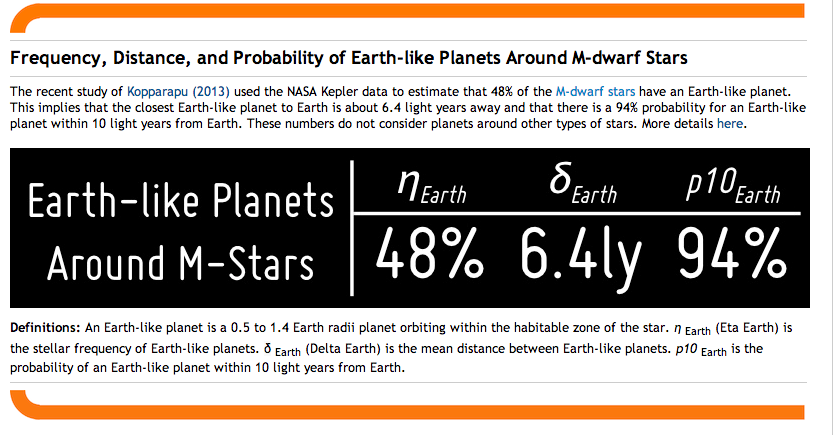
Earths are too small for WFIRST to take pics.
But the DARPA telescope could take images of these nearby worlds, if it were turned towards them. Instead of looking for "pale blue dots" around nearby stars which may be homes to life, perhaps even civilizations, it will be doing this at your or someone elses city, house, backyard or whatever they choose.

So in comparison to the donated NRO telescopes which could only take pictures of giant planets like Jupiter, the DARPA telescope talked about in the Space.com article if it were aimed at nearby star systems with a coronagraph would be able to take images of small planets like the Earth.
They would look something like this:
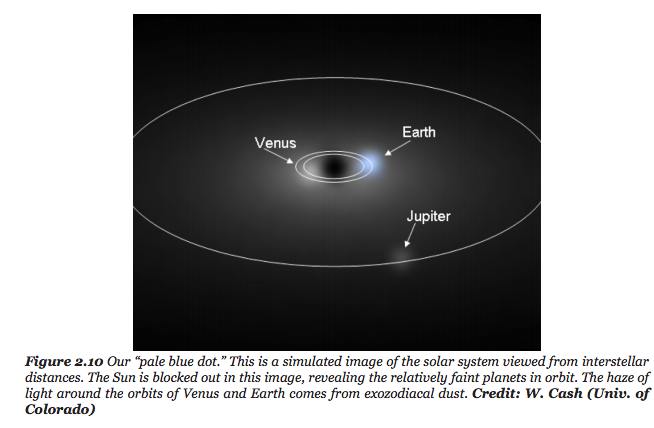
Basically we'd see nearby "Earths" as pale blue dots out to about 40-50 light years.
Big deal you might say...
Well, that would allow us to analyze their atmospheres to see if life is likely present there:

That would then spur on the development of even larger telescopes to take detailed pictures of these nearby earths.
And what would be required to do that?
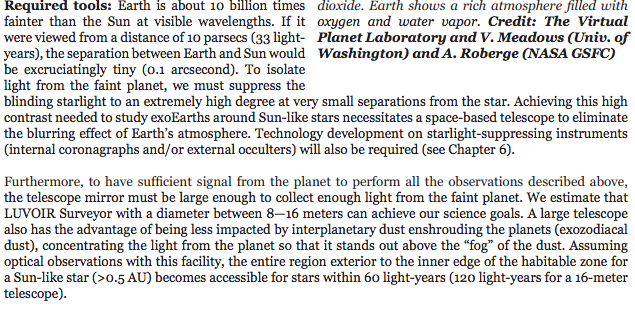
Gee, all they need is an 8 to 16 meter space telescope to do that?
To bad the US National Security people will have a 20 meter one at their disposal spying on god only knows what at that resolution on Earth....
BTW: All of this, regarding the requirements to image another Earth comes from this report by NASA which lays out a roadmap for its astrophysics missions for the next 30 years. SEE: Enduring Quests, Daring Visions - NASA Astrophysics in the Next Three Decades
So in summation, the US Military-Intelligence agencies will have a telescope more capable of looking at nearby Earthlike planets (similar to the one discovered recently by Kepler) for signs of life than ANYTHING NASA has received funding to build now or in the next 20 years.
But it will be pointed the wrong way, at the Earth to see high res images of...... fill in the blank.
I am all for national security, I understand the need for surveillance and monitoring of enemy states. But in a world where the 'enemy' is hazily defined and can change from a nation state, to a lone individual there is something unnerving about some of the greatest telescopic instruments being designed not to potentially uplift humanity, but to survey, surveil and subjugate some if not all of it in the name of?
Furthermore, because this research is done through the military, much of the research may end up classified which will mean we have to spend more tax dollars reinventing the wheel when we actually get around to NASA building a similar telescope (See Hubble: The NRO had Hubble sized telescopes pointing at the Earth for 15-20 years before Hubble was funded for development and launch).
Your tax dollars at work.
Priorities.
edit on 20-4-2014 by JadeStar because: (no reason given)
What we deem important to spend money on in this Country, is a tragedy.
Our young will be last in the world at the rate we spend on science, education, and space.
Much better to devise ways to kill man, and restrain him, than to uplift him...
I'm Mr. Meeseeks, Look at me!
Well done thread S&F ... If all the things developed for and by DARPA/military complex were actually put to use in the real world no telling how much
all of mankind could benefit... Horrible how in some ways the wheel has to be reinvented time after time.
How does this rank in comparison to the virtual telescope tech that I heard so much about a few years ago.
You know, the type that uses multiple site locations across the earth and the distance between the sites becomes the overall size of the virtual mirror. Thus achieving mirror sizes that were thousands of miles in diameter.
Sorry for the laymen's definition of this, I'm going by memory here and I'm not in the field at all.
But it seems this wouldn't be as good as the quality of those virtual ones or am I missing the technical part of this completely?
Please explain, if anyone can.
You know, the type that uses multiple site locations across the earth and the distance between the sites becomes the overall size of the virtual mirror. Thus achieving mirror sizes that were thousands of miles in diameter.
Sorry for the laymen's definition of this, I'm going by memory here and I'm not in the field at all.
But it seems this wouldn't be as good as the quality of those virtual ones or am I missing the technical part of this completely?
Please explain, if anyone can.
edit on 4/20/2014 by AnteBellum because: spelling
originally posted by: JadeStar
...But the DARPA telescope could take images of these nearby worlds, if it were turned towards them. Instead of looking for "pale blue dots" around nearby stars which may be homes to life, perhaps even civilizations, it will be doing this at your or someone elses city, house, backyard or whatever they choose...
I'm not an expert on telescopes, but I know that Hubble's angular resolution prevents it from seeing things that are close to it (the Moon, Earth, Mars, etc) with a really high resolution. It is great for light-capturing, which lets it see far-away galaxies, but if you used it to view Mars, the Moon, or even to spy on Earth, the image would not be that great.
So I wonder what the angular resolution would be on this proposed DARPA scope, and would it be useful as a "spy telescope" for spying on Earthlings?
I always thought that black projects are kept secret, and the industrial military complex was far more advanced then we have thought? So wouldn't
this telescope be obsolete to them?
Anyways they rather shackle us then have us use our true potential as a species, it's discusting.
I seen your last post about the Earth size planet discovered in the habitable zone, this should be used to detect the chemical composition of that planet! We are a species of discovery not slavery SnF thank you.
Anyways they rather shackle us then have us use our true potential as a species, it's discusting.
I seen your last post about the Earth size planet discovered in the habitable zone, this should be used to detect the chemical composition of that planet! We are a species of discovery not slavery SnF thank you.
edit on 20-4-2014 by muSSang because: (no reason given)
edit
on 20-4-2014 by muSSang because: (no reason given)
originally posted by: AnteBellum
How does this rank in comparison to the virtual telescope tech that I heard so much about a few years ago.
You know, the type that uses multiple site locations across the earth and the distance between the sites becomes the overall size of the virtual mirror. Thus achieving mirror sizes that were thousands of miles in diameter.
Sorry for the laymen's definition of this, I'm going by memory here and in not in the field at all.
But it seems this wouldn't be as good as the quality of those virtual ones or am I missing the technical part of this completely?
Please explain, if anyone can.
Yes the virtual telescope and busing many earth based scopes together works... However the key word is earth based where they have to look through earth's atmosphere. Also many of the network scopes are doing their own thing and unless there is some astronomical event worthy of breaking into their normally scheduled viewing events it just does not happen as far as I know..
This Darpa scope will be placed in geosync orbit to stare at the earth which is B.S. unless there is no cloud cover....... then no telling if it can be used to see what brand barbeque sauce you purchased at your favorite grocery store?
This proposed DARPA 20 meter telescope seemed to me like overkill for even most of the missions a spy satellite would have (looking at enemy
instillations, weaponry, troop movements, etc)
So I decided to do some back-of-the-envelope calculations of what the capabilities of such a large telescope in orbit pointed at the earth would have. (Don't worry I will spare you the boring math.)
First off...
I made a number of assumptions based on what we know about the retired 2.4 meter telescopes the NRO gave NASA and their rumored capabilities when they were "State of the Art".
The telescopes given to NASA, if equipped with what would have been available when others like them were launched would have been able to at the read a license plate or even newspaper headline from orbit. There's also the possibility through use of advanced (and likely classified) image processing or adaptive optics that they might have been able to read a newspaper story from orbit.
So what could this telescope do from orbit?
Well I calculated that it could have as fine resolution as between 7mm and 1mm from a geosynchronous orbit.
That's good enough to spot a gray hair on your head.
Read your tattoo? Easily.
Spot a birthmark? Childsplay.
Or if the lighting and light angle was right and atmospheric conditions relatively clear, take an iris scan of a person from orbit for purposes of gathering biometrics for a database or tracking a particular individual.
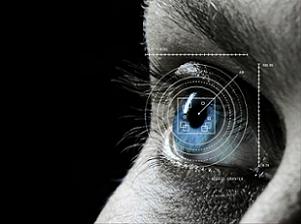
Now, I am not a paranoid person. Nor am I anti-government (much of the research I am studying and doing in college is government funded).
However, beyond the "whaaaa, why can't we use this for science?!" sentiment I have there is part of me that is uneasy about this level of detail from orbit in the hands of people we will never know and whose motivations may be, at times suspect (remember the naked pictures from the millimeter wavelength airport body scanners being circulated amongst TSA people?).
The potential for the abuse of a surveillance platform like this which could catalog every man, woman and child on Earth gives me pause and may be unnerving to others.
It gets better. If they used this telescope in the near-infrared wavelengths, they'd be able to count and track how many people are in your house from orbit during the night or a cold day.
Enemy of the State anyone?
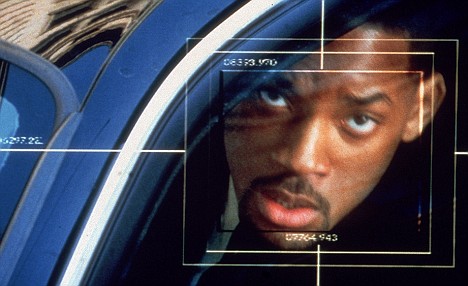
So I decided to do some back-of-the-envelope calculations of what the capabilities of such a large telescope in orbit pointed at the earth would have. (Don't worry I will spare you the boring math.)
First off...
I made a number of assumptions based on what we know about the retired 2.4 meter telescopes the NRO gave NASA and their rumored capabilities when they were "State of the Art".
The telescopes given to NASA, if equipped with what would have been available when others like them were launched would have been able to at the read a license plate or even newspaper headline from orbit. There's also the possibility through use of advanced (and likely classified) image processing or adaptive optics that they might have been able to read a newspaper story from orbit.
So what could this telescope do from orbit?
Well I calculated that it could have as fine resolution as between 7mm and 1mm from a geosynchronous orbit.
That's good enough to spot a gray hair on your head.
Read your tattoo? Easily.
Spot a birthmark? Childsplay.
Or if the lighting and light angle was right and atmospheric conditions relatively clear, take an iris scan of a person from orbit for purposes of gathering biometrics for a database or tracking a particular individual.

Now, I am not a paranoid person. Nor am I anti-government (much of the research I am studying and doing in college is government funded).
However, beyond the "whaaaa, why can't we use this for science?!" sentiment I have there is part of me that is uneasy about this level of detail from orbit in the hands of people we will never know and whose motivations may be, at times suspect (remember the naked pictures from the millimeter wavelength airport body scanners being circulated amongst TSA people?).
The potential for the abuse of a surveillance platform like this which could catalog every man, woman and child on Earth gives me pause and may be unnerving to others.
It gets better. If they used this telescope in the near-infrared wavelengths, they'd be able to count and track how many people are in your house from orbit during the night or a cold day.
Enemy of the State anyone?

edit on 20-4-2014 by JadeStar because: (no reason given)
originally posted by: AnteBellum
How does this rank in comparison to the virtual telescope tech that I heard so much about a few years ago.
You know, the type that uses multiple site locations across the earth and the distance between the sites becomes the overall size of the virtual mirror. Thus achieving mirror sizes that were thousands of miles in diameter.
What you're describing is known as an interferometer.
They can have huge resolving power but not at optical wavelengths on Earth. Typically interferometry is done at the radio/microwave and millimeter wavelengths.
So while those types of telescopes like ALMA or the Square Kilometer Array will have great resolution, they will not operate in the visual part of the electromagnetic spectrum.
Sorry for the laymen's definition of this, I'm going by memory here and I'm not in the field at all.
But it seems this wouldn't be as good as the quality of those virtual ones or am I missing the technical part of this completely?
Please explain, if anyone can.
No worries, it was a very good question. It's too bad we can't do that type of interferometry on Earth at optical wavelengths.
It -is- possible to do it in space though and there were two cancelled missions (Terrestrial Planet Finder at NASA and Project Darwin in Europe with the ESA) which would have done that.
BTW: The Square Kilometer Array will be a powerful instrument capable of spotting the alien equivalent of an airport radar many light-years away.

edit on 20-4-2014 by JadeStar because: (no reason given)
originally posted by: JadeStar
So I decided to do some back-of-the-envelope calculations of what the capabilities of such a large telescope in orbit pointed at the earth would have. (Don't worry I will spare you the boring math.)
First off...
I made a number of assumptions based on what we know about the retired 2.4 meter telescopes the NRO gave NASA and their rumored capabilities when they were "State of the Art".
You can't get anywhere near that resolution with a 2.4 meter telescope from LEO. Adaptive optics or no. Rayleigh's criterion sets the limit of angular resolution for any optic telescope.
a reply to: JadeStar
If you want inside info on how that business works, meaning, the intel agencies get all of the good stuff first, I suggest you read The Hubble Wars by Eric J. Chaisson a scientist and textbook author. He worked with developing the Hubble telescope. The book is about the battles between the engineers, politics and scientists putting the program together, but he also gives us some intriguing insights in how the intel agencies operate to delay and avoid open science revealing too much of their secret devices.
In this regard, it was the huge spy telescopes already in orbit that were the equal to the Hubble when the Hubble was only a dream on paper. Their scopes were looking down, not outward. He goes to some length detail how he thinks that the original Hubble mirror, on purpose, was ground with a faulty surface so that it was far from perfect and, thus, in a roundabout and incredibly expensive way would not give our enemies any clues as to how precise were our optics. It is one of those billion dollar errors that our money buys all of the time.
If you want inside info on how that business works, meaning, the intel agencies get all of the good stuff first, I suggest you read The Hubble Wars by Eric J. Chaisson a scientist and textbook author. He worked with developing the Hubble telescope. The book is about the battles between the engineers, politics and scientists putting the program together, but he also gives us some intriguing insights in how the intel agencies operate to delay and avoid open science revealing too much of their secret devices.
In this regard, it was the huge spy telescopes already in orbit that were the equal to the Hubble when the Hubble was only a dream on paper. Their scopes were looking down, not outward. He goes to some length detail how he thinks that the original Hubble mirror, on purpose, was ground with a faulty surface so that it was far from perfect and, thus, in a roundabout and incredibly expensive way would not give our enemies any clues as to how precise were our optics. It is one of those billion dollar errors that our money buys all of the time.
originally posted by: JadeStar
As you know, one thing which gets under my skin as a student of science is the money that gets wasted on duplicate research and instruments that science wants but the military locks up under the auspices of "National Security".
Reading your article, it sure sounds like those awful guys at NRO are giving away optics left and right.
DARPA's doing an awful lot of describing the basic idea as well for something that's going to be classified. If NASA had the budget, they could design their own. That's where your problem lies. NASA's budget is too small.
Now, if you really want something to whine about, wait until you see what the NRO is cooking up. I'd say you'll hear about it in the MSM in maybe 20, 30 years.
This telescope would be able to take a pale blue dot image of the Earth from a distance of 175 light years away.
How many star systems are there within 175 light years away?
Try 78,778 star systems which we could look for pale blue dots around. Most of which are completely unknown.
My math...
A parsec is 3.26 light-years.
Using the 0.120 stars/cubic parsec number, and using a volume for a distance 175 light-years = 175/3.26 = 53.68 parsecs
Number = density * volume
= 0.120 stars/cubic parsec * 4/3 pi (53.68 parsecs)^3
= 78,778 stars
Note: I counted multiple star systems (like Alpha Centauri) as a single system.
How many star systems are there within 175 light years away?
Try 78,778 star systems which we could look for pale blue dots around. Most of which are completely unknown.
My math...
A parsec is 3.26 light-years.
Using the 0.120 stars/cubic parsec number, and using a volume for a distance 175 light-years = 175/3.26 = 53.68 parsecs
Number = density * volume
= 0.120 stars/cubic parsec * 4/3 pi (53.68 parsecs)^3
= 78,778 stars
Note: I counted multiple star systems (like Alpha Centauri) as a single system.
edit on 20-4-2014 by JadeStar because: (no reason
given)
originally posted by: Bedlam
originally posted by: JadeStar
So I decided to do some back-of-the-envelope calculations of what the capabilities of such a large telescope in orbit pointed at the earth would have. (Don't worry I will spare you the boring math.)
First off...
I made a number of assumptions based on what we know about the retired 2.4 meter telescopes the NRO gave NASA and their rumored capabilities when they were "State of the Art".
You can't get anywhere near that resolution with a 2.4 meter telescope from LEO. Adaptive optics or no. Rayleigh's criterion sets the limit of angular resolution for any optic telescope.
Not a 2.4 meter. The proposed 20 meter one DARPA is working on designing. Sorry if I wasn't clear on that.
So what you're saying is that this is the most powerful telescope ever designed that could feasibly be built and launched into space, yet instead of
looking into the vast distances of space to advance science they are going to turn it towards the earth so they can spy on whomever they wish? Sounds
about like the military.
How can they afford something like this? The US needs to cut its military budget, and put it to better use. We should just stay out of conflicts altogether. That's why we have nukes, to act as a deterrent so we don't have to fight. No country will attack us, which I suppose is why we are waging war on "terror." Whatever that means.
I can only imagine the great breakthroughs that have been made in the US, but under the auspices of national security have been kept from us? Think of the benefits to humankind. I mean wow. It is just insane. Think about this...theoretically just about anything can be related to national security. Or an argument can be made that it is important to national security. If the government would have been as obsessed with national security further back in time, we probably wouldn't even have the internet. They probably wish we don't, because then we really wouldn't have a clue as to what was going on.
How can they afford something like this? The US needs to cut its military budget, and put it to better use. We should just stay out of conflicts altogether. That's why we have nukes, to act as a deterrent so we don't have to fight. No country will attack us, which I suppose is why we are waging war on "terror." Whatever that means.
I can only imagine the great breakthroughs that have been made in the US, but under the auspices of national security have been kept from us? Think of the benefits to humankind. I mean wow. It is just insane. Think about this...theoretically just about anything can be related to national security. Or an argument can be made that it is important to national security. If the government would have been as obsessed with national security further back in time, we probably wouldn't even have the internet. They probably wish we don't, because then we really wouldn't have a clue as to what was going on.
originally posted by: Aliensun
a reply to: JadeStar
If you want inside info on how that business works, meaning, the intel agencies get all of the good stuff first, I suggest you read The Hubble Wars by Eric J. Chaisson a scientist and textbook author. He worked with developing the Hubble telescope. The book is about the battles between the engineers, politics and scientists putting the program together, but he also gives us some intriguing insights in how the intel agencies operate to delay and avoid open science revealing too much of their secret devices.
Thank you! I've just ordered this!
originally posted by: JadeStar
Not a 2.4 meter. The proposed 20 meter one DARPA is working on designing. Sorry if I wasn't clear on that.
If it were a 20 meter reflector, you'd get about an inch, if you were at the sort of high LEO that NRO likes. A Fresnel design with a sparse matrix design like MOIRE won't reach a Rayleigh resolution. Still, 2 inches or so beats six, which is about what they get now. From geosynchronous orbit, you might get a meter resolution, maybe a bit better.
I'm also not sure you could do LEO with a membrane telescope due to it being subject to tidal distortions from masscons. Which is probably why they're talking about putting this thing in geosynch.
originally posted by: Bedlam
originally posted by: JadeStar
Not a 2.4 meter. The proposed 20 meter one DARPA is working on designing. Sorry if I wasn't clear on that.
If it were a 20 meter reflector, you'd get about an inch, if you were at the sort of high LEO that NRO likes. A Fresnel design with a sparse matrix design like MOIRE won't reach a Rayleigh resolution. Still, 2 inches or so beats six, which is about what they get now. From geosynchronous orbit, you might get a meter resolution, maybe a bit better.
I'm also not sure you could do LEO with a membrane telescope due to it being subject to tidal distortions from masscons. Which is probably why they're talking about putting this thing in geosynch.
Wouldn't advanced adaptive optics and image processing (which I am assuming they'd be using) get the resolution a bit finer that that by a factor of 10? Can we calculate the Rayleigh limit for an advanced AO system on a 20 meter mirror?
And I agree about LEO. I assumed GEO for that reason. So somewhere between LEO and GEO then?
You're much better versed in spysats than I am so what altitude are we talking for the NRO sats?
edit on 20-4-2014 by JadeStar because: (no reason given)
originally posted by: JadeStar
Well I calculated that it could have as fine resolution as between 7mm and 1mm from a geosynchronous orbit.
That's good enough to spot a gray hair on your head.
Read your tattoo? Easily.
Spot a birthmark? Childsplay.
Or if the lighting and light angle was right and atmospheric conditions relatively clear, take an iris scan of a person from orbit for purposes of gathering biometrics for a database or tracking a particular individual.
Have you seen the new Captain America?
It proposes some scary things with this type of thing, in point of fact the whole movie seems to be an Indictment against the Intelligence complex.
originally posted by: JadeStar
Wouldn't advanced adaptive optics and image processing (which I am assuming they'd be using) get the resolution a bit finer that that by a factor of 10? Can we calculate the Rayleigh limit for an advanced AO system on a 20 meter mirror?
The limit is set by diffraction effects. No matter how tricky your post-processing, there is a limit on the maximum amount of information that can be transferred through a certain aperture. You can't enhance what you haven't got. It's sort of like a bad spy show (24 comes to mind) where they've got a low res camera feed and the guy says "Enhance...enhance...enhance.." until you can count hairs on the guy's face. You can't actually do that. AO is great for helping you get closer to the Rayleigh criterion limit, but you have to start there as the best you're ever going to do and it's downhill from there.
And in this case, you've got other diffraction limits rearing their ugly heads. One is that the MOIRE is a sparse matrix. That is, it's not a solid array of lensing - more like a doughnut. That cuts down your resolution some. Matching the images from the different panels costs you some, the fact that the fresnel engraving on the panels isn't perfect and isn't infinitely small costs you some. It's real nice, don't get me wrong, and it's a big leap forward, but you aren't going to be reading the postage stamps on the letter the guy's holding at the mailbox.
It's off to work for me, sad to say, another day at the MIC saltmine.
new topics
-
Supreme Court Oral Arguments 4.25.2024 - Are PRESIDENTS IMMUNE From Later Being Prosecuted.
Above Politics: 1 hours ago -
Krystalnacht on today's most elite Universities?
Social Issues and Civil Unrest: 1 hours ago -
Chris Christie Wishes Death Upon Trump and Ramaswamy
Politicians & People: 1 hours ago -
University of Texas Instantly Shuts Down Anti Israel Protests
Education and Media: 3 hours ago -
Any one suspicious of fever promotions events, major investor Goldman Sachs card only.
The Gray Area: 6 hours ago -
God's Righteousness is Greater than Our Wrath
Religion, Faith, And Theology: 10 hours ago
top topics
-
VP's Secret Service agent brawls with other agents at Andrews
Mainstream News: 15 hours ago, 11 flags -
Nearly 70% Of Americans Want Talks To End War In Ukraine
Political Issues: 15 hours ago, 6 flags -
Sunak spinning the sickness figures
Other Current Events: 15 hours ago, 5 flags -
Supreme Court Oral Arguments 4.25.2024 - Are PRESIDENTS IMMUNE From Later Being Prosecuted.
Above Politics: 1 hours ago, 4 flags -
Electrical tricks for saving money
Education and Media: 13 hours ago, 4 flags -
Krystalnacht on today's most elite Universities?
Social Issues and Civil Unrest: 1 hours ago, 3 flags -
Late Night with the Devil - a really good unusual modern horror film.
Movies: 17 hours ago, 3 flags -
Any one suspicious of fever promotions events, major investor Goldman Sachs card only.
The Gray Area: 6 hours ago, 2 flags -
University of Texas Instantly Shuts Down Anti Israel Protests
Education and Media: 3 hours ago, 2 flags -
Chris Christie Wishes Death Upon Trump and Ramaswamy
Politicians & People: 1 hours ago, 1 flags
active topics
-
Nearly 70% Of Americans Want Talks To End War In Ukraine
Political Issues • 76 • : FlyersFan -
University of Texas Instantly Shuts Down Anti Israel Protests
Education and Media • 83 • : FlyersFan -
The Reality of the Laser
Military Projects • 49 • : 5thHead -
British TV Presenter Refuses To Use Guest's Preferred Pronouns
Education and Media • 154 • : PorkChop96 -
Supreme Court Oral Arguments 4.25.2024 - Are PRESIDENTS IMMUNE From Later Being Prosecuted.
Above Politics • 2 • : xuenchen -
President BIDEN Vows to Make Americans Pay More Federal Taxes in 2025 - Political Suicide.
2024 Elections • 142 • : xuenchen -
Chris Christie Wishes Death Upon Trump and Ramaswamy
Politicians & People • 6 • : mysterioustranger -
"We're All Hamas" Heard at Columbia University Protests
Social Issues and Civil Unrest • 282 • : 5thHead -
Candidate TRUMP Now Has Crazy Judge JUAN MERCHAN After Him - The Stormy Daniels Hush-Money Case.
Political Conspiracies • 745 • : network dude -
-@TH3WH17ERABB17- -Q- ---TIME TO SHOW THE WORLD--- -Part- --44--
Dissecting Disinformation • 664 • : 777Vader
